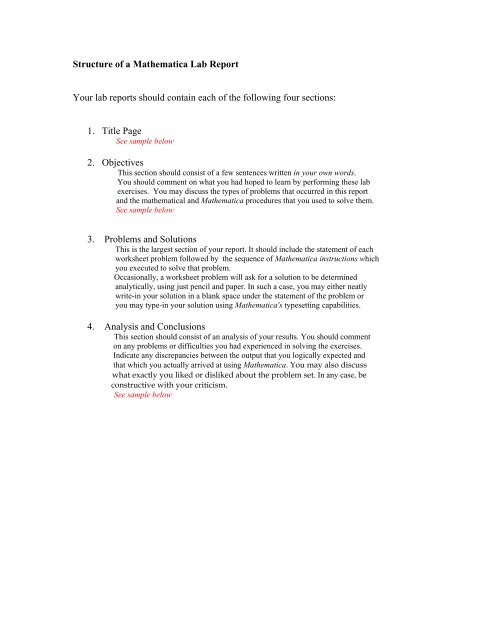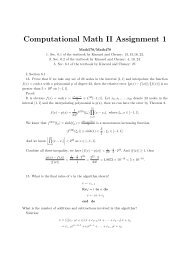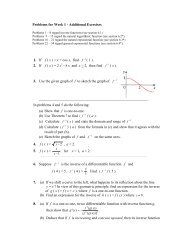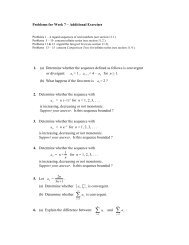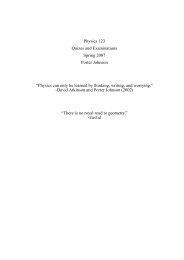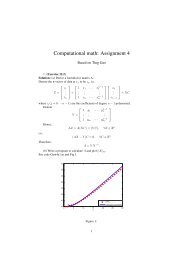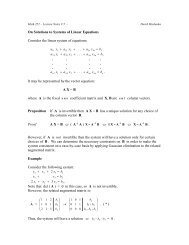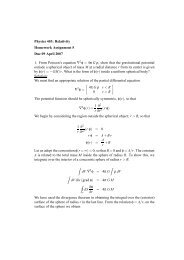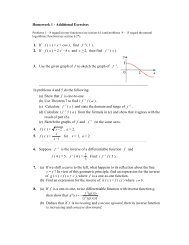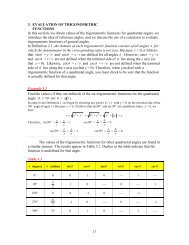Format of a Mathematica Lab Report
Format of a Mathematica Lab Report
Format of a Mathematica Lab Report
You also want an ePaper? Increase the reach of your titles
YUMPU automatically turns print PDFs into web optimized ePapers that Google loves.
Structure <strong>of</strong> a <strong>Mathematica</strong> <strong>Lab</strong> <strong>Report</strong><br />
Your lab reports should contain each <strong>of</strong> the following four sections:<br />
1. Title Page<br />
See sample below<br />
2. Objectives<br />
This section should consist <strong>of</strong> a few sentences written in your own words.<br />
You should comment on what you had hoped to learn by performing these lab<br />
exercises. You may discuss the types <strong>of</strong> problems that occurred in this report<br />
and the mathematical and <strong>Mathematica</strong> procedures that you used to solve them.<br />
See sample below<br />
3. Problems and Solutions<br />
This is the largest section <strong>of</strong> your report. It should include the statement <strong>of</strong> each<br />
worksheet problem followed by the sequence <strong>of</strong> <strong>Mathematica</strong> instructions which<br />
you executed to solve that problem.<br />
Occasionally, a worksheet problem will ask for a solution to be determined<br />
analytically, using just pencil and paper. In such a case, you may either neatly<br />
write-in your solution in a blank space under the statement <strong>of</strong> the problem or<br />
you may type-in your solution using <strong>Mathematica</strong>'s typesetting capabilities.<br />
4. Analysis and Conclusions<br />
This section should consist <strong>of</strong> an analysis <strong>of</strong> your results. You should comment<br />
on any problems or difficulties you had experienced in solving the exercises.<br />
Indicate any discrepancies between the output that you logically expected and<br />
that which you actually arrived at using <strong>Mathematica</strong>. You may also discuss<br />
what exactly you liked or disliked about the problem set. In any case, be<br />
constructive with your criticism.<br />
See sample below
PART I. SAMPLE: TITLE PAGE<br />
MATH 152-01<br />
CALCULUS II<br />
THE NUMBER e AS A LIMIT,<br />
LOGARITHMIC AND EXPONENTIAL FUNCTIONS<br />
<strong>Lab</strong> #1<br />
Richard Ford<br />
Due Date: June 8, 2010<br />
Instructor: D. Maslanka
PART II. SAMPLE: OBJECTIVES<br />
Objectives<br />
This was the first time that I had encountered the program ‘<strong>Mathematica</strong>’. Therefore, by<br />
completing the lab 1 problem set, I had hoped to become familiar with this program and<br />
to begin to learn something about its uses. The first lab assignment covered a variety <strong>of</strong><br />
different mathematical problems, ranging from solving elementary equations to<br />
performing complex integrations. The procedures used to solve these problems were<br />
consistent with those used in the lectures. Moreover, <strong>Mathematica</strong> programming<br />
reminded me <strong>of</strong> other more familiar programming tools such as MATLAB and C++.<br />
PART IV. SAMPLE: ANALYSIS & CONCLUSIONS<br />
Analysis and Conclusions<br />
The first problem in this report was a relatively simple one for me to solve. So it was a<br />
good one to get me into the swing <strong>of</strong> <strong>Mathematica</strong> programming. In contrast, problems 3<br />
and 4 were much more challenging. Their solutions required a lot more trial and error on<br />
my part. Although the fundamental ideas behind them were not too complicated, it was<br />
still difficult for me to translate these two problems in terms <strong>of</strong> the <strong>Mathematica</strong> program.<br />
Of course, it <strong>of</strong>ten is the case that initial difficulties will arise whenever you first<br />
experiment with a brand new programming tool. However, after getting some help from<br />
the TA and a little advice from the instructor, I was able to figure out most <strong>of</strong> the<br />
<strong>Mathematica</strong> formulas that I needed to solve all <strong>of</strong> the problems.<br />
The numerical results were mostly what I had expected. Overall, I thought that these four<br />
exercises formed a very good initial problem set. The questions posed were neither too<br />
simple nor overly complicated to serve as an introduction to <strong>Mathematica</strong> programming.


